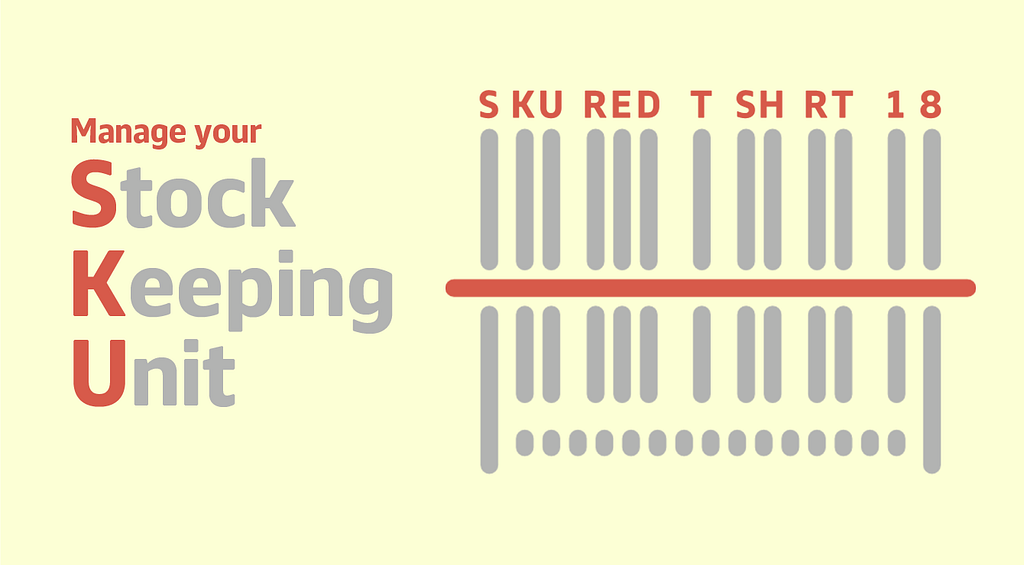Latest news about Bitcoin and all cryptocurrencies. Your daily crypto news habit.

Do you remember the school days, when your class teacher used “Roll numbers” for daily attendance? Did you ever wonder why they never called by names?
Well, there are several answers to this question:
- It becomes difficult to call out the whole name.
- It’s time-consuming.
- Creates confusion for the students with identical names.
Likewise, when it comes to inventory management, the warehouse where you store inventory stock, can be related to your class. Because the warehouse is the place where your stock sits.
Hence the students of the warehouse (inventory) require a ‘roll number’ so that you can identify each of your students uniquely. This assigning roll numbers to each unit of stock in the warehouse is known as ‘Stock Keeping Unit or SKU’.
SKU meaning or definition
SKU (pronounced “skew”) is a code consisting of letters and numbers, usually six to eight characters long, that you (and your team-mates) can use to search and identify product or stock.
Each product or group of products (i.e 100 pieces of t-shirt, blue color, size medium) have the same SKU. The barcode number on each of them always differ to uniquely identify, but the SKU number remains the same to identify that the piece product’s item belongs to a specific group.
As your business starts growing you need to have an SKU system, to identify and organize your inventory effectively. And if you are doing business via wholesale or retail channels devising SKU becomes vital. Because it becomes an unwieldy process to uniquely identify each product or inventory in the large warehouse.
Importance of SKU
SKU’s are most used by the catalogs, brick and mortar stores, online retailers, warehouse managers, and order fulfillment centers, to trace inventory level in order to know that specific inventory needs reordering or not.
Having an efficient SKU system helps the above-mentioned users to manage and plan their inventory in multiple ways (similarly like class teachers with roll-number).
- Lookup product information easily: It’s very easy and faster for a retailer to search by SKU to look up any product information. Being a wholesaler to another store, there may be instances like customers asking “what size” and “what color”, during that they can use your specified SKU to get that information from your store quickly.
- Quickly find your product: Having SKU code on inventory can help warehouse managers locate what they need even more efficiently. SKU allows warehouse operators to find the exact product that they need with both speed and accuracy, which is necessary to keep up with customer demand.
- Smoothens the 3PL working process: If you’re working with top 3PL companies, then keeping SKU code across all the inventory let you and your 3PL partner identify your product easily, without getting confused with others.
- Identifying and organizing products using SKUs makes for very straightforward reconciling of stock levels.
- Improve business decision-making: You get the idea of your major profit streams, by tracking product variants with SKU. It also helps you make strategic product decisions to expand your business.
Now let’s see how SKUs can be particularly helpful for products that have variants and the best practices to manage them.
Difference between SKU and UPC
SKUs are sometimes thought to be synonymous with UPC bar codes, but they are not. For SMB business owners and operators who manage inventory, it’s important to know the difference “big difference” between them.
If you are doing international business, for some countries, you may need to use a special 13 characters UPC called an International Article Number (IAN) or European Article Number (EAN).
Practices to manage SKU
Different companies may have different methods of assigning SKU to their products. However, there are some best and easy methods or ways which can be used to manage the SKU’s for better inventory management. Below are a few of them:
Generate SKU codes that could be understood
Just imagine there’s an SKU code like this “X$%U-xO0*-QU%1!”. Don’t you think it would be a tedious task for your brain to decipher this type of SKU? Also, there are high chances of selecting or getting wrong info of product/inventory by keeping so complex SKU number.
Don’t load or assign SKU number with something (e.g. 1 is red, 11 is Summer, 12 is Large). Keep SKU code as simple as possible and easy to understand. Conclusively SKU is to record important information of an inventory, so the more simple SKU it is, the better for everyone.
What attributes to use and what-not-to in SKU
Think of what SKU code would you keep for a product (Winter 2019, Full-sleeve Men’s Jacket, Medium, Red). Remember there may be many similar products, hence identifying the significant attributes is must for creating an effective SKU.
So you can use attributes like year and season will help you narrow down the search to the specific collection and inventory immediately, rather than less important attributes like color and size.
Therefore the SKU code which I would keep for the better understanding of the above product would be:
Winter 2019, Full-sleeve Men’s Jacket, Medium, Red= WN19-MJAC-FL-MR
Summer 2019, Half-sleeve Women’s Jacket, Medium, Red= SM19-WJAC-HL-MR
Fonts and Characters
Don’t use confusing characters or Homoglyph that looks similar in nature — O or 0 zero, g or 9, k or K, I (ice-cream) or l (leather). The font and characters you use to print your SKU codes play an important part in making sure that the reader is not confused.
Avoid using symbols in your SKU codes. Even though it might seem like a good idea to use the ‘/’ to create breaks within your code, but you don’t want Excel auto-formatting the numbers, confusing them with a date. Other characters like $, &, %, !, | and @ are too confusing and cause formatting errors as well as human error all the time.
SKU numbering
- While creating SKU number, make sure that the first 2 or 3 digits or characters of SKU should represent a top-level identifier. The top-level identifier can be a department, your store category, or even a supplier.
- Use the SKU’s middle numbers to assign unique identifiers or unique features like, category, subcategory, size, color; anything that goes well while organizing the product you sell.
- Finally, for the last series of SKU number using sequential numbering like 001, 002, 003 makes setup simple and also helps you easily distinguish between the older and newer product line.
Some Good SKU Code Examples:
Here are a few products and their sample product SKU Codes which describe the Brands, Season, Product, Colour, and the Size of apparels.
- PUMA Wallet Red Small — PMA-WAL-RED-SMA
- DELL Monitor, 2019 Model, Black color, 21 inch — DEL19-MON-21BL
- Adidas sports shoe size 8 white color –ADI-WHI-SS-08.
- ChicBrand Blue Medium — CHI-SHI-BLU-MED
- Spring 2018, Flower Tee, Small, Red — S18T-FLR-RS
- Baskin-Robbins Strawberry Cake and candles, 1-kg weight SKU would be –1K-BRSB-CKC
SKU and Inventory Management Software
Let’s jump back again to the school days when we all had a class monitor — who used to look after the students when the teacher was not present. Here your inventory management software plays the role of a class monitor, while students are the SKU’s.
Class monitors used to maintain discipline among students so that decorum of the class was not disturbed. Likewise, the inventory management softwares manages the SKU’s that are added in it. Adding SKU codes to your inventory management tool have its own benefits:
- Improves cycle counting:
- Sorting products (by type, size, color, etc.)
- Increase accuracy in warehouse procedures
- Stock count for a specific product becomes easy.
Conclusion
I hope now you know better why our class teachers used to take attendance by calling out roll-numbers rather than the full name.
Apart from having a good and easy to understand SKU number, having a thoughtful and well-maintained inventory management software that accepts the SKU number created by you makes business more efficient and more profitable.
Best practices to manage SKU for inventory management was originally published in Hacker Noon on Medium, where people are continuing the conversation by highlighting and responding to this story.
Disclaimer
The views and opinions expressed in this article are solely those of the authors and do not reflect the views of Bitcoin Insider. Every investment and trading move involves risk - this is especially true for cryptocurrencies given their volatility. We strongly advise our readers to conduct their own research when making a decision.


